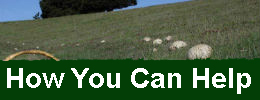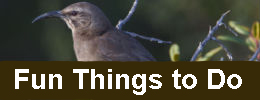See our new printable trail map for western Knowland Park.

This is an annotated aerial view of Knowland Park, made from Google Earth data. Click to see a larger, more detailed version.
Here is an interactive animated hiking trail map of western Knowland Park, from the Everytrail website, a very good source for user-supplied and user-annotated trail information.
Here is an article about the Hikes and Trails in Knowland Park.
And here is a suggested hike: From Malcolm, turn on Ettrick and park by the fire road gate. Take a left just after you go through the gate and stroll along past houses on your left, with the meadow on your right side for about a two-block distance, until you come to a little bench overlooking the park at the Cameron Street entrance.
Looking toward San Francisco to the west, notice two tall Eucalyptus trees that protrude above the farthest horizon, Near the one to the right is where the 3-story 34000 square foot interpretive center, restaurant, gift shop and offices are proposed to be sited.
Near a small evergreen tree on your right, turn and walk diagonally to your right on the footpath worn in the grass, heading slightly northwest. If the weather is good, from this path there are wonderful views of Oakland, San Francisco, and the Bay as well as the lush green oak-studded hills to the west in the park itself.
Depending on the season and time of day, this is a great place to hear the melodious song of Meadowlarks, and in the evening, frogs from the ‘valley’ to your left may be singing. The large dead tree prominent in front of you is a favorite hunting perch for Red-tailed Hawks and, at night, for Great Horned Owls who dive to catch gophers, mice, and other small rodents in the grass.
Join a wide fire road and keep going roughly the same direction, towards the right from the first road. When you come to an intersection of four fire roads, turn hard left and go down the hill, now heading directly toward the Bay.
As you reach the bottom of this long grade, look to your left and see a beautiful large heritage oak with a red spot on its trunk. This indicates that it is slated to be cut down for the expansion, despite the fact that it lies outside the proposed expansion area. The red marks on trees throughout the park indicate trees slated for removal.
At the bottom of the hill, make your way around a muddy spot that locals call Lake Willbegone, used by frogs for breeding in the rainy season and distinguished by dry, cracked ground in the dry season.
At about the central point of this “Lake Willbegone” junction is where the expansion project fenceline is proposed to go, cutting across the fire road and heading across the hillsides in both directions roughly north and south.
At this wide junction, rather than continuing on straight up the slope, turn and head up the hill to the left (roughly south).
If the expansion proceeds you will no longer be able to walk here.
As you make your way up this hill, look back and around to see the views of the mesa from which you came and the wonderful rock outcroppings.
The grasslands to your right (and to some degree to the left) are some of the richest stands of native grasslands in the Park. These will become part of animal enclosures under the Zoo expansion proposal, which will destroy these stands. According to the California Native Grasslands Association, less than 1% of California’s native grasslands remain.
At the summit of this hill, which locals call “Heartbreak Hill,” gaze up and down the Bay. On a fine day, you can see five bridges from here, as well as downtown Oakland and San Francisco.
As you walked up this hill, you passed through an area proposed to become enclosures for the captive mountain lion and jaguar. The fenceline will run almost next to the large oak tree at the top. If built as proposed, you willl be looking into a fence and Zoo exhibits where you now have unobstructed 360 degree views from this hill.
Rather than take the steepest route down from the top, which heads straight for the Bay, turn on the more gentle path heading north to your right and walk down to another intersection of fire roads.
Near this intersection, a children’s splash area with pop jets is proposed. This entire area will be fenced off from hiking under the plan. There will be buildings, walkways and other structures as well as a paved service road.
Bearing to the center roughly in the same direction but heading a bit left, walk downhill. Any of the roads going from this area lead to dead ends or to the back fence of the present Oakland Zoo. The main one, which goes past a small cell phone antennae station, goes downhill a short distance and makes a nice small loop through a beautiful grove of oaks.
This grove of heritage oaks is where the expansion project would site a campground for 100 people with platform tents. It is adjacent to a very rare stand of native chaparral, a high-fire risk plant community.
Go as far as you like and then double back the way you came. Back at the intersection, turn on the first fire road to your left, a short dead end road.
This road takes you to a dead end which is where the proposed interpretive center building is planned. You will likely see survey stakes and poles indicating where the building is proposed to go. The 60-foot aerial gondola towers would be constructed coming up from the existing Zoo and across through the area of rare chaparral to your left. Fire clearance requirements around buildings constructed on high-fire risk slopes such as this will likely mean eliminating most vegetation. To see another heritage oak slated for removal, walk to your right when you reach the end of the road and down a little slope. Enjoy the lovely spreading and entwining branches of this tree while you can!
Return to the fire road and go back to the main intersection. Here, turn left and head east back toward the mesa area from whence you came, heading downhill to Lake Willbegone. This time, instead of going straight back up the way you came, turn left and head north and then northeast along a fire road that features fine views of the north hills to your left and, eventually, of upper Knowland Park, a separate section of the park located above Golf Links Road.
To your left would be the wolf enclosure, planned to be built atop another rare and tiny plant, the bristly leptosiphon. Some nice rock outcroppings are to your right, but watch out for the poison oak that grows around them! On the right as you head uphill, during spring and early summer, there are lovely stands of Blue-eyed grass here, distinguishable by their lovely brilliant blue flowers.
At the first junction, a road to the right leads back up toward where you started; a road to your left leads to Golf Links Road.
While this area is outside the “official” expansion area, the brush and trees have been chainsawed down on both sides of the road leading to Golf Links.
Instead, continue straight on, heading east now, and enjoy the views to your left from this part of the mesa. In about ¼ mile, wind around toward the right through a more forested area on the north side, enjoying the lush green grass (mostly not native, however) on the slope that drops down toward Grass Valley.
This area of the park also has lovely wildflowers and other native plants in season, but mostly not the very rare ones found in the expansion area.
Upon reaching another fire road, turn right and notice an enormous oak tree with a lovely spreading shape. Head back toward the west and the top of the mesa area where you entered, turning at your first left to go back to Ettrick Street and the entrance. It’s hard to get lost here, since the entire park is bounded on the south side by the houses near Ettrick, Lochard, Cameron, and the other streets that dead-end at the park, and on the west by the views of the Bay.
There are always new things to see in the park. Enjoy its peacefulness while you can and do your part to keep it clean. And if you support our efforts to protect the park for future generations by urging a less destructive Zoo expansion, please register on our website, contact us to find out what you can do, or make a donation!
 Follow
Follow
